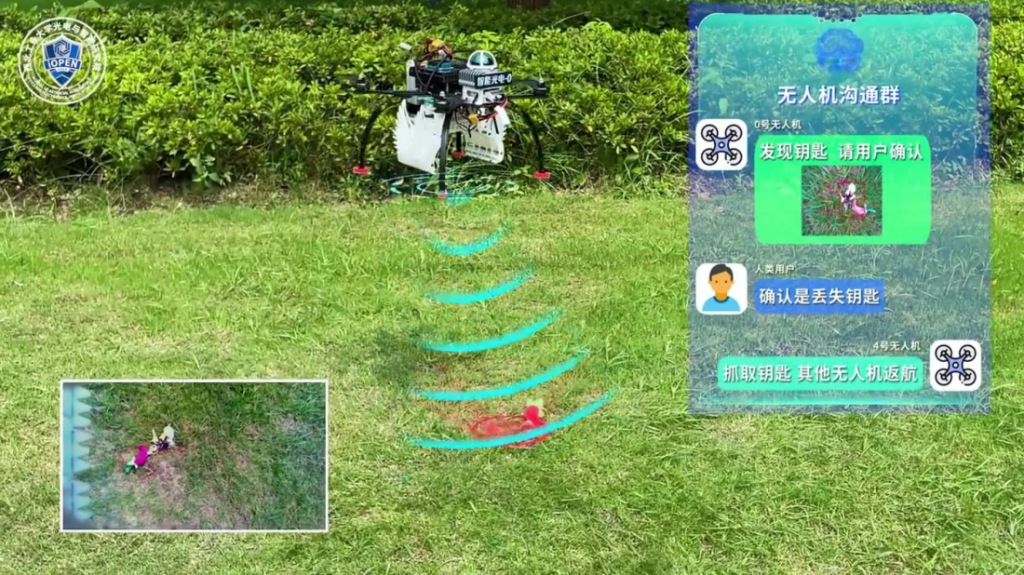Member
- Joined
- Oct 14, 2023
- Messages
- 225
- Thread Author
- #1
Group chats between drones become the basis for performing complex tasks.
A Chinese research team has created drones with "human brains" that can coordinate their actions and perform complex tasks, using group chats to communicate. This technology promises a breakthrough in the areas of security, rescue operations and air logistics.
Researchers from the School of Artificial Intelligence, Optics and Electronics at Northwestern Polytechnic University in Shaanxi Province, led by Li Xuelong, have developed a system that allows drones to communicate and collaborate like human teams.

Having found a bunch of lost keys in the park, the drone sends a photo to a group chat and asks the human operator to confirm before picking up the item.
Unlike traditional drone swarm communication strategies, which are usually modeled on the behavior of bees and ants, the Chinese team proposed a concept that allows drones to communicate and collaborate using natural language. It also makes the machines ' thought processes transparent to humans, allowing them to better understand their behavior.
The technology is based on the use of the Chinese open big language model InternLM. This allows drones not only to communicate with each other, but also to interact with operators in human language, reducing the barriers between man and machine.
A demonstration video released by the university shows five drones successfully finding lost keys in a park. Three drones immediately "offered" their search abilities, while the other two, equipped with grapples, informed the group of their ability to pick up keys. The division of tasks was independently solved by the drone cluster.
Drones are equipped with a variety of sensors and algorithms for low-altitude search, dynamic obstacle avoidance, and visual positioning, allowing them to collect data and perform tasks efficiently.
Researchers emphasize the significant potential of the new technology: It promises to transform security operations, accelerate and improve disaster response operations, and dramatically optimize logistics processes using drones.
Previously, Lee's team investigated optics-controlled drones that use high-energy lasers for remote power, potentially giving them unlimited endurance.
In October, Lee led the development of an underwater drone navigation system called Navigator
A Chinese research team has created drones with "human brains" that can coordinate their actions and perform complex tasks, using group chats to communicate. This technology promises a breakthrough in the areas of security, rescue operations and air logistics.
Researchers from the School of Artificial Intelligence, Optics and Electronics at Northwestern Polytechnic University in Shaanxi Province, led by Li Xuelong, have developed a system that allows drones to communicate and collaborate like human teams.

Having found a bunch of lost keys in the park, the drone sends a photo to a group chat and asks the human operator to confirm before picking up the item.
Unlike traditional drone swarm communication strategies, which are usually modeled on the behavior of bees and ants, the Chinese team proposed a concept that allows drones to communicate and collaborate using natural language. It also makes the machines ' thought processes transparent to humans, allowing them to better understand their behavior.
The technology is based on the use of the Chinese open big language model InternLM. This allows drones not only to communicate with each other, but also to interact with operators in human language, reducing the barriers between man and machine.
A demonstration video released by the university shows five drones successfully finding lost keys in a park. Three drones immediately "offered" their search abilities, while the other two, equipped with grapples, informed the group of their ability to pick up keys. The division of tasks was independently solved by the drone cluster.
Drones are equipped with a variety of sensors and algorithms for low-altitude search, dynamic obstacle avoidance, and visual positioning, allowing them to collect data and perform tasks efficiently.
Researchers emphasize the significant potential of the new technology: It promises to transform security operations, accelerate and improve disaster response operations, and dramatically optimize logistics processes using drones.
Previously, Lee's team investigated optics-controlled drones that use high-energy lasers for remote power, potentially giving them unlimited endurance.
In October, Lee led the development of an underwater drone navigation system called Navigator